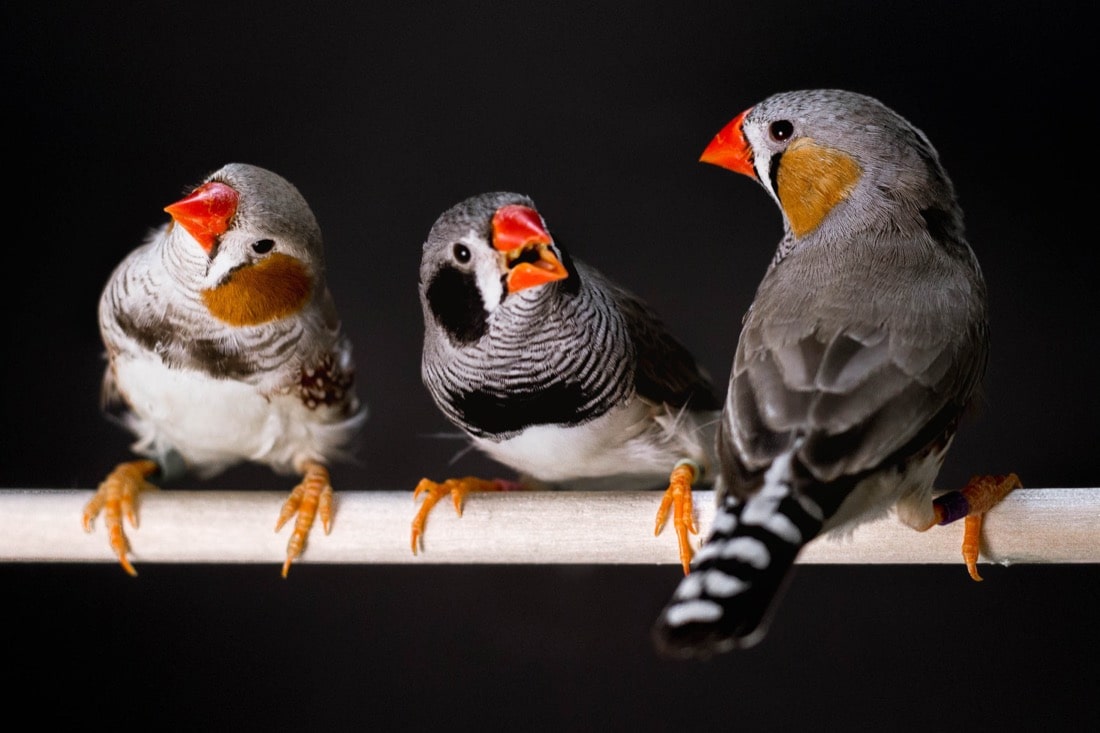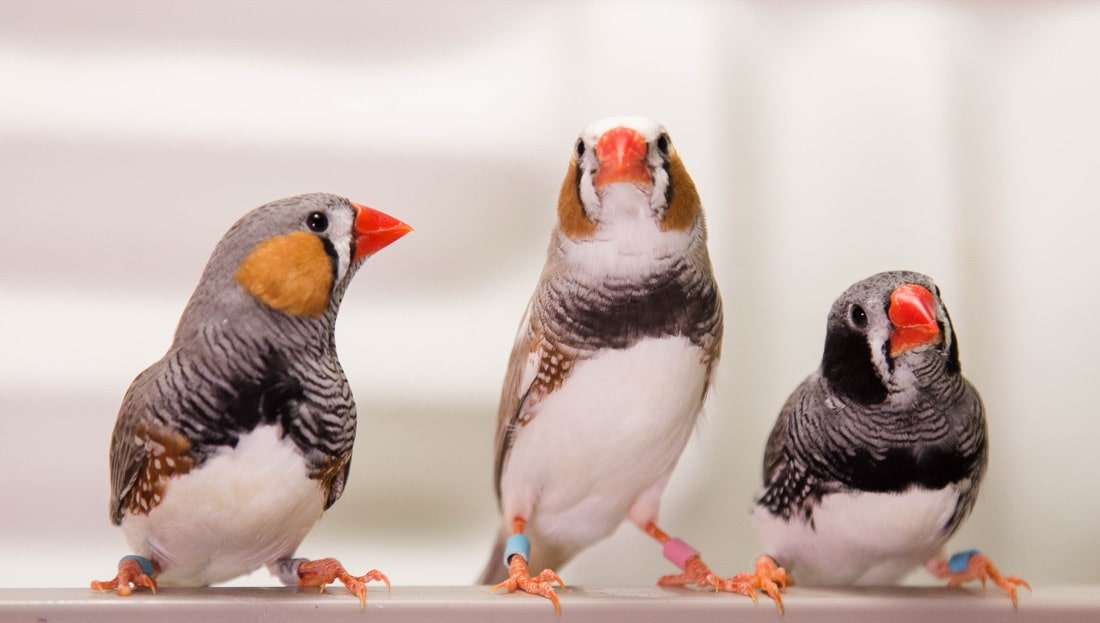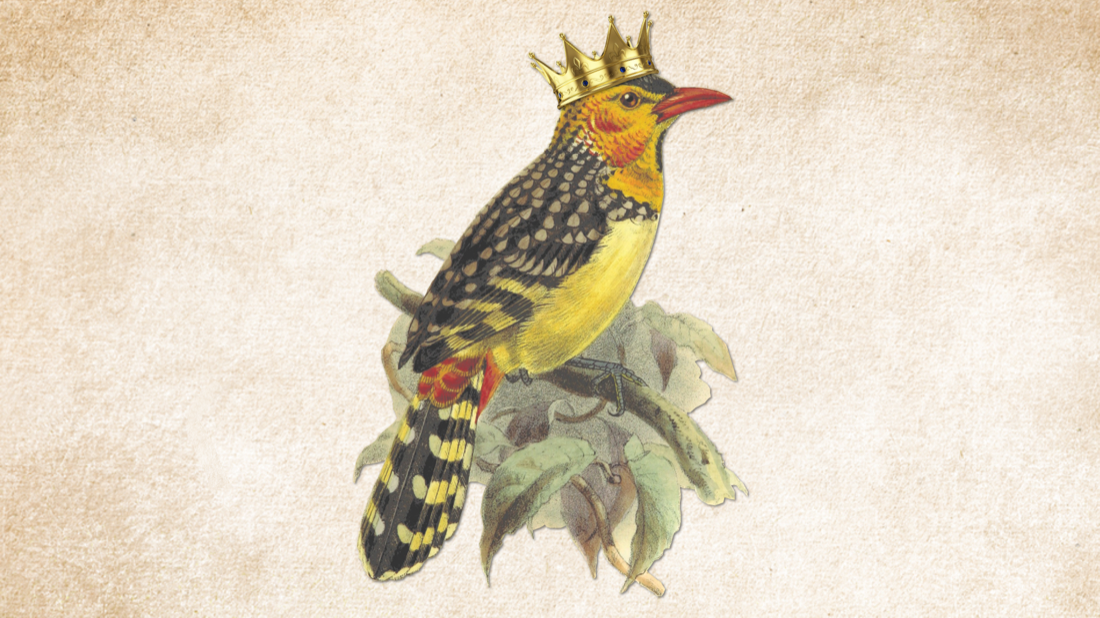Practice Makes Perfect: How Birds Learn To Sing
16:39 minutes
 This story is part of our summer Book Club conversation about Jennifer Ackerman’s book ‘The Genius of Birds.’ Want to participate? Sign up for our newsletter or send us your thoughts on the SciFri VoxPop app.
This story is part of our summer Book Club conversation about Jennifer Ackerman’s book ‘The Genius of Birds.’ Want to participate? Sign up for our newsletter or send us your thoughts on the SciFri VoxPop app.
When a baby human learns to talk, there’s a predictable pattern of learning: First, they listen to the language spoken around them, then they babble and try to make the same sounds, and then they eventually learn the motor skills to shape that babble into words and meaning.
Researchers who study songbirds know this is also the process by which a baby male zebra finch learns the unique songs that as an adult he will use to mate and defend territory. The same holds true for canaries, nightingales, warblers, and beyond. And for many birds, like humans, the window where they learn their “language” best is a short one that closes early in life.
In fact, bird song is studied closely as an analogy for human speech—an example of sophisticated brain machinery for learning that evolved separately in birds and humans. Jon Sakata, associate professor of biology at McGill University, explains how the babble of baby zebra finches could lead us to a deeper understanding of how the brain produces speech—as well as how and why learning changes over our lifetimes.
Plus, Ira checks in with Book Club captain Christie Taylor about our summer read, Jennifer Ackerman’s The Genius of Birds.


 Calling All Bird Brains!
Calling All Bird Brains!We hope you’ll join us for Egghead: The Genius of Birds on August 29, 2019 in NYC! The Science Friday Book Club invites you to an indoor birding adventure, where we’ll explore the lives and minds of our fowl friends. Learn more and buy tickets here.
Jon Sakata is an associate professor of biology at McGill University in Montreal, Quebec.
Christie Taylor was a producer for Science Friday. Her days involved diligent research, too many phone calls for an introvert, and asking scientists if they have any audio of that narwhal heartbeat.
IRA FLATOW: This is Science Friday. I’m Ira Flatow. If you’ve ever watched a baby learn how to talk, you know that it’s a messy process because first the baby has to hear you talk, then there’s that babbling, right, all that random sound as the baby starts to figure out how to use its muscles to make the sounds that it’s hearing from adults.
And then finally, the baby starts to figure it out, and you get those first exciting words. And then before you know it, your baby is all grown up, defending his territory, and wooing mates.
[BIRD SQUAWKING]
Oh, wait, wait– did I say human babies? I should have said all of this is how songbirds– like the zebra finch you just heard– learn to produce the complicated patterns of notes they must memorize if they want any chance of reproductive success in adulthood. But in labs that study these birds, researchers are also thinking about the parallels between bird learning and human speech.
Birdsong is one of the closest analogs in nature to how we talk, it turns out, and studying how birds learn in infancy may open windows into our brains. Here with more to talk about that, my guest, Dr. Jon Sakata, associate professor of biology at McGill University in Montreal. Good to have you.
JON SAKATA: Hi, Ira, thanks for having me.
IRA FLATOW: Thanks for coming down. So how close is birdsong to human speech?
JON SAKATA: We think there are a lot of parallels between birdsong and human speech, and you’ve outlined a lot of them in your description. Just thinking of the process by which birds have to learn how to produce their own vocalizations, their own species-typical vocalizations, is really similar to how children have to figure out how to produce these speech sounds to communicate with others in their environment.
So they go through this, it’s fundamentally the same across species that learn their own vocalizations. So it first involves learning the sounds of the sound that you use to communicate, and then involves learning how to produce those sounds, so figuring out the motor patterns or the motor commands to produce those particular sounds.
Now, that first phase is sort of just memorizing the sounds of the adults around them and then memorizing a song that they ultimately want to sing that’s sort of their target song. And then they go through this, like you said, they babble, and they start practicing, and they figure things out. Sometimes they get things wrong, sometimes they get things right, and when they get things right, the brain says, aha, that’s great. You did some good, keep doing that. And eventually, they grow up singing their own songs.
IRA FLATOW: Is this unique to birds, this kind of learning? Do other animals do this?
JON SAKATA: Well, there are a handful of other birds– so there’s songbirds, so within the large [INAUDIBLE] of birds, there are songbirds. There about 4,000 to 5,000 songbirds that learn their own songs. There are also hummingbirds that learn their own songs, and also parrots, they’re fairly well known for being vocal learners.
But outside of birds, there are a number of mammals. For example, well, humans being one of the main ones we think about. Bats also are vocal learners.
IRA FLATOW: Bats? Wow.
JON SAKATA: Bats, yes. And so this is a relatively– people have become to appreciate that more and more in the last couple decades. Cetaceans like dolphins and whales, also vocal learners. And there’s some new evidence that elephants can imitate human sounds, so there’s vocal learning in elephants. So there’s a pretty neat sort of group of vertebrates that can learn the vocalizations.
And it’s not as extensively studied in those other systems, but it’s really well studied in birds, and we know that that whole process of sensory learning and then vocal practice and finish in motor learning. But I think it’s going to be fleshed out– my bet is it’s ultimately going to be the same thing in bats and in elephants.
IRA FLATOW: Interesting. I want to bring back that bird we heard before when I did the introduction. Let’s hear it again.
[BIRD SQUAWKING]
Zebra finch?
JON SAKATA: Yes.
IRA FLATOW: OK, so what is the zebra finch telling us?
JON SAKATA: It’s saying, this is me. I’m singing. And it does this all the time. So what is it doing? We don’t know. We’re trying to figure that out. But it sings a lot. And it sings when it’s by itself.
It sings when it’s courting a female. And it really is, the song that it produces when it’s courting a female, it’s really one of the most important things that females use to pick who to mate with. And so the bird has to do this really well.
So he spends a bunch of time– what we think, when he’s singing by himself, is that we actually think he might be practicing just to make sure he’s keeping up his vocal skills. And then when he sees a female, he’s in his ultimate, his best performance, and he shows off his vocal skills, if you will.
IRA FLATOW: So you have a lab full of these birds?
JON SAKATA: We do have a lab full.
IRA FLATOW: What a noisy place!
JON SAKATA: Well, it would be lovely to have them just flying around, but we do have them in the sound-attenuated chambers so we can have the recordings of them in an acoustically-clean environment, just like you have here in the studio. But we do have them also flying around, as well, in other parts.
IRA FLATOW: So you’re trying to figure out what’s going on in their brains when they’re doing the songs?
JON SAKATA: Yes.
IRA FLATOW: That’s what you’re trying to do.
JON SAKATA: Both the learning of the song, and the production of the song as well. So we think that songbirds are really interesting. I mean, there are a lot of animals that communicate with each other with sounds, but songbirds, I think, are really interesting and I think special because they’re not born with this ability to produce their own species songs but because they have to learn them. And so studying that learning process, I think, is what really makes songbirds an interesting and important model system to study with regard to brain mechanisms.
IRA FLATOW: So do they have a center in their brain like we might have?
JON SAKATA: They have many centers, so–
IRA FLATOW: For these songs?
JON SAKATA: Yes, there’s a series of brain areas that are connected to each other that have parallels in the human brain. So for example, there’s a part of the brain– a series of interconnected brain areas– called the basal ganglia, and people think about that a lot in humans with regard to movement. And when things go awry in Parkinson’s disease, you often have some things that go wrong in the basal ganglia itself.
But what’s neat about songbirds is they also have this basal ganglia, and within the basal ganglia, they have this specialized portion called Area X– it’s a very attractive name.
IRA FLATOW: Area X.
JON SAKATA: Area X. I like the way you say it.
IRA FLATOW: It’s a TV show coming up about birds.
JON SAKATA: Exactly. So that area is specialized for song learning. And if you mess with activity in that brain area during development, birds don’t learn their songs particularly well. And so we think that there are parts of the human basal ganglia that are important for vocal learning as well and that are similar to this Area X you see in birds.
IRA FLATOW: You know, in people, we say that people learn things better earlier in life. Is that the same thing with the birds learning their songs, or do they learn it their whole life?
JON SAKATA: There are species differences in how long they– for how old they can keep learning their songs for. So the zebra finches that we study, they only learn their songs during the first month or two of their lives. And so it’s a really restricted window of development. And these zebra finches sing one song their whole life. So this one or two months of development is really important for them to learn and crystallize their songs.
But there are other species, like mockingbirds and European starlings, that are what we call open-ended learners that can learn songs throughout their lifetime. And so we are really interested in trying to figure out what is different in the brains of these two different types of birds.
IRA FLATOW: Because they’re imitating other birds, right?
JON SAKATA: Yeah, it’s amazing. They can even imitate nonavian sounds, so car alarms, for example, being a classic example for what mockingbirds can do, right? And how do they do that? I mean, we don’t know. But we’re trying to figure that out.
IRA FLATOW: And so your lab is investigating whether song learning also is influenced by social interact– what do you mean by that?
JON SAKATA: So humans– babies, children– can learn from watching videos and learn how to say particular things, but it’s not particularly robust learning. And we as a people learn much better if we’re allowed to socially interact with an adult or with a peer, and that leads to more robust and efficient learning. And this same thing happens in songbirds.
When you have a juvenile bird that’s being tutored by another adult, that bird learns the song of that adult bird much better versus in comparison to a juvenile that’s housed individually and just hears song being played back passively out of a speaker. So we compare these song learning under social situations or social contexts and song learning in response to passive exposure to song. And we see, again, more robust learning when juveniles are allowed to socially interact with adults.
IRA FLATOW: Hmm. Is birdsong a language? Are the birds talking to one another?
JON SAKATA: So as songbird researchers, we try to be really careful about what we say birdsong is analogous to. And so for the most part, we say that birdsong is analogous to speech and not to language, per se.
IRA FLATOW: By the way, so what’s the difference? I mean, speech, language.
JON SAKATA: Yeah, so when we talk about it, as scientists when we talk about it, we think of speech as sort of the motor that really just the– how do you produce the sounds that comprise language? And when we talk about language, we think of the semantic content, the syntax, sort of the meaning that’s within language itself that we’re trying to communicate.
And we know birds do communicate particular things with their vocalizations, but the repertoire of meanings of things that they communicate is much more restricted than that what we see in human language. So we think that they can’t convey an infinite number of things about the environment as far as we can tell. And so we think that what’s the most parallel between birdsong and human speech is sort of the production aspect of it.
IRA FLATOW: So you’re saying that birds are not taking different little songs and putting them together like we would take different words as we speak?
JON SAKATA: Some birds do so, but not to the same extent as humans do. There’s this thing called combinatorial syntax, and some birds do put different calls together to form different meanings. It’s a really neat field, but–
IRA FLATOW: I’m pushing back on this. That sounds like speech to me.
JON SAKATA: It sounds a little bit like language, a little bit. There are people who study this and think about the linguistic principles in birdsong, and I think there are certainly phenomena that birds do that are akin to language, but I think we wouldn’t argue that’s the same scope of human language in terms of–
IRA FLATOW: And birds that can imitate human speech, are they doing something different?
JON SAKATA: We don’t know. We don’t know a lot about those kind of birds. They’re really interesting. I mean, the ability to mimic human speech probably has something to do with things in the periphery, you know, so what can their muscles do, the beak and the tongue, and can they ultimately produce those sounds.
But it’s probably not just that, too, there’s probably some differences in the brain of these birds that can imitate human speech and birds that can’t do that. But ultimately, I think, my guess is that they’re using the same circuits, the same brain areas for learning human speech or how to produce human speech as learning how to produce another birdsong in these mimics.
IRA FLATOW: In the birds that you study? I’m thinking about like parrots imitating people.
JON SAKATA: No, yeah, that’s fantastic. We don’t know anything about how parrots do that. And zebra finches can’t do that.
IRA FLATOW: They can’t do that, huh?
JON SAKATA: They can sing their own species song, but they can’t say hello to us. It’d be nice if we had a colony full of birds saying hello to us in the morning, but we don’t have that.
IRA FLATOW: It might get tiresome after a while!
JON SAKATA: It might, yeah.
IRA FLATOW: So what can we learn about humans? If you study the brains of these birds, what is it going to tell you about us?
JON SAKATA: Well, I think there’s been a lot of research into trying to find these parallels between bird brains and human brains. And I think there’s a lot of evidence to say that a lot of these areas that we see in songbirds that are important for song learning are really similar to areas that we find important for speech learning and acquisition in humans.
So if we study these processes in songbirds, maybe we can get some insight into the processes that are involved in speech acquisition in humans. Furthermore, we can study– there are individuals with deficits, have communication disorders, so deficits in learning how to speak and how to produce language. And there are a number of genes that have been implicated in these communicative disorders.
And one thing we can do is those same genes are expressed in– a lot of those same genes are expressed in songbirds, and we can actually ask, to what extent do these individual genes– if you introduce a variant into a songbird brain, can that also lead to deficits in communication in the songbird? So you can help really look for the genetic substrates underlying communication disorders by using songbirds as an animal model system.
IRA FLATOW: I’m Ira Flatow. This is Science Friday from WNYC Studios. Do you find it that birds are actually smarter than we give them credit for?
JON SAKATA: I think they’re smart at doing all the stuff that they’re meant to do, and I think we just have to come up with the right tests to– but I think they surprise us a lot.
IRA FLATOW: Yeah. Were you surprised by their singing ability? Anything surprise you?
JON SAKATA: No, I mean, I think the amount that they sing is pretty amazing. We have some studies where we gave them these random sets of sequences, and we found that what happens is that they– oh, sorry. When you give them these random sounds of their zebra finch sounds, they pull out sequences that are really typical of the sequences you see in the wild.
So we think that the brain is biased to learn these species-typical sequences that you see. So you give them this random garbage of sounds, well, random sequence design, they pull out things that their species would use for communication.
IRA FLATOW: Interesting. Thank you very much, Jon Sakata, associate professor of biology at McGill University in Montreal. Thank you for taking time to be with us today.
We’re celebrating birdsong and other brainy bird tricks this month with our SciFri Book Club, reading the book The Genius of Birds by Jennifer Ackerman. And here with a couple of updates on what the club’s been doing, SciFri producer, book and bird nerd, Christie Taylor.
CHRISTIE TAYLOR: Hey, Ira.
IRA FLATOW: OK, welcome back. What’s the report from the book club trenches?
CHRISTIE TAYLOR: Well, we’ve been reading for a couple weeks now. And we’ve been having some great on-air conversations about smart birds with our listeners on Facebook about what kinds of intelligence we can measure in birds including these great tricks of navigation, problem solving, and of course, the communication that we just talked about with Dr. Sakata. And then, of course, other neat tricks, like this one Ken in Lawrence, Kansas, told us about on the SciFri VoxPop app.
KEN: The friend in Hays, Kansas, who watched a western kingbird put cigarette butts in the nest for the young ones because it supposedly repels ticks, mites, and other pests, which I think is a learned behavior. Obviously, it’s not genetic programming. I think that’s very smart.
CHRISTIE TAYLOR: That’s Ken in Kansas on our new Science Friday VoxPop app, which lets people chime in on different Science Friday questions using their phone microphone. And we have two questions like that right now for our book club readers. So you can join on in, and find the Science Friday VoxPop app wherever you get your apps.
And Ira, our listeners have been sharing stories about all kinds of smart bird behavior they’ve been seeing– cardinals begging them to refill the bird feeder, crows cracking nuts on the sidewalk, Megan in San Jose saw a crow dipping stale French fries in water to soften them up.
IRA FLATOW: That’s pretty smart. You know, I love how smart crows are because I’ve seen them a lot. And we’ve been learning about the New Caledonian crows’ amazing puzzle-solving abilities. Just reading in the book how they make tools, but also how they use tools. And they use tools to get another tool, and they’ll eventually get them the food that they need.
CHRISTIE TAYLOR: Yeah, and they also seem to have cultural differences in how they make these tools, depending on where they live. They pass this down through families.
I’m also personally getting really excited about bowerbirds. They make these really beautiful elaborate nests. Each species seems to have a different sense of aesthetics, favorite colors, tricks with perspective that they do to lure their females, and maybe even a sense of artistry, which is a fun debate we can have next week.
IRA FLATOW: Well, is it too late for newcomers to join in the book club?
CHRISTIE TAYLOR: Absolutely not. You can still pick up The Genius of Birds by Jennifer Ackerman and start reading, find our discussion group on Facebook, and go looking for birds near you with our iNaturalist challenge. Take a photo on your phone, send it in, and you will be contributing valuable citizen science data. That’s all on ScienceFriday.com/BookClub.
IRA FLATOW: There you go. Christie Taylor, Science Friday producer and wrangler for our book club.
Copyright © 2019 Science Friday Initiative. All rights reserved. Science Friday transcripts are produced on a tight deadline by 3Play Media. Fidelity to the original aired/published audio or video file might vary, and text might be updated or amended in the future. For the authoritative record of Science Friday’s programming, please visit the original aired/published recording. For terms of use and more information, visit our policies pages at http://www.sciencefriday.com/about/policies/
Christie Taylor was a producer for Science Friday. Her days involved diligent research, too many phone calls for an introvert, and asking scientists if they have any audio of that narwhal heartbeat.
Ira Flatow is the founder and host of Science Friday. His green thumb has revived many an office plant at death’s door.